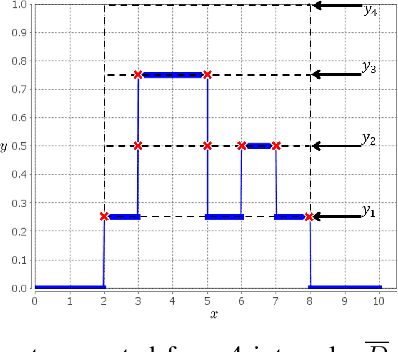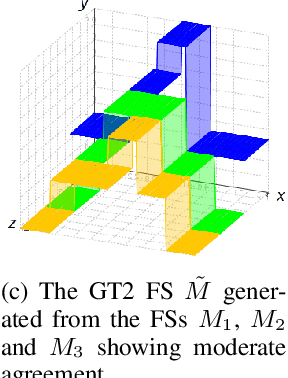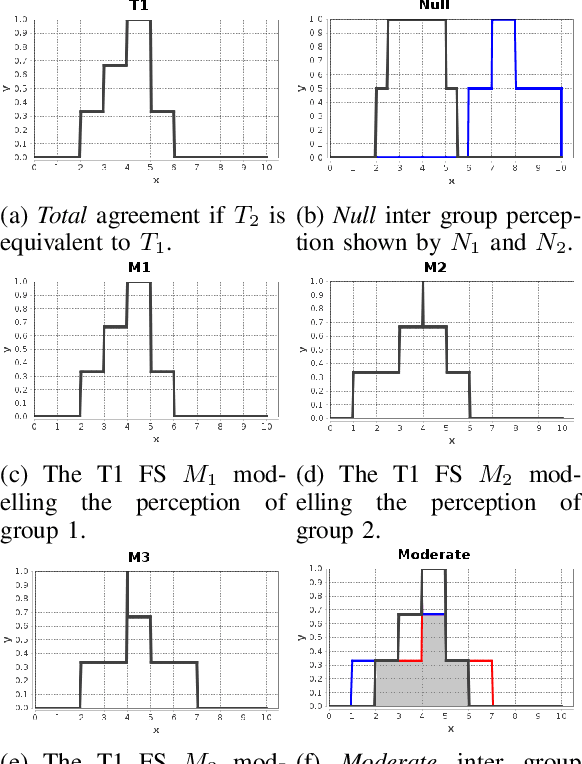Javier Navarro
Measuring Inter-group Agreement on zSlice Based General Type-2 Fuzzy Sets
Jul 09, 2019



Abstract:Recently, there has been much research into modelling of uncertainty in human perception through Fuzzy Sets (FSs). Most of this research has focused on allowing respondents to express their (intra) uncertainty using intervals. Here, depending on the technique used and types of uncertainties being modelled different types of FSs can be obtained (e.g., Type-1, Interval Type-2, General Type-2). Arguably, one of the most flexible techniques is the Interval Agreement Approach (IAA) as it allows to model the perception of all respondents without making assumptions such as outlier removal or predefined membership function types (e.g. Gaussian). A key aspect in the analysis of interval-valued data and indeed, IAA based agreement models of said data, is to determine the position and strengths of agreement across all the sources/participants. While previously, the Agreement Ratio was proposed to measure the strength of agreement in fuzzy set based models of interval data, said measure has only been applicable to type-1 fuzzy sets. In this paper, we extend the Agreement Ratio to capture the degree of inter-group agreement modelled by a General Type-2 Fuzzy Set when using the IAA. This measure relies on using a similarity measure to quantitatively express the relation between the different levels of agreement in a given FS. Synthetic examples are provided in order to demonstrate both behaviour and calculation of the measure. Finally, an application to real-world data is provided in order to show the potential of this measure to assess the divergence of opinions for ambiguous concepts when heterogeneous groups of participants are involved.
Exploring Differences in Interpretation of Words Essential in Medical Expert-Patient Communication
Jul 21, 2016



Abstract:In the context of cancer treatment and surgery, quality of life assessment is a crucial part of determining treatment success and viability. In order to assess it, patients completed questionnaires which employ words to capture aspects of patients well-being are the norm. As the results of these questionnaires are often used to assess patient progress and to determine future treatment options, it is important to establish that the words used are interpreted in the same way by both patients and medical professionals. In this paper, we capture and model patients perceptions and associated uncertainty about the words used to describe the level of their physical function used in the highly common (in Sarcoma Services) Toronto Extremity Salvage Score (TESS) questionnaire. The paper provides detail about the interval-valued data capture as well as the subsequent modelling of the data using fuzzy sets. Based on an initial sample of participants, we use Jaccard similarity on the resulting words models to show that there may be considerable differences in the interpretation of commonly used questionnaire terms, thus presenting a very real risk of miscommunication between patients and medical professionals as well as within the group of medical professionals.
Applying Interval Type-2 Fuzzy Rule Based Classifiers Through a Cluster-Based Class Representation
Jul 21, 2016



Abstract:Fuzzy Rule-Based Classification Systems (FRBCSs) have the potential to provide so-called interpretable classifiers, i.e. classifiers which can be introspective, understood, validated and augmented by human experts by relying on fuzzy-set based rules. This paper builds on prior work for interval type-2 fuzzy set based FRBCs where the fuzzy sets and rules of the classifier are generated using an initial clustering stage. By introducing Subtractive Clustering in order to identify multiple cluster prototypes, the proposed approach has the potential to deliver improved classification performance while maintaining good interpretability, i.e. without resulting in an excessive number of rules. The paper provides a detailed overview of the proposed FRBC framework, followed by a series of exploratory experiments on both linearly and non-linearly separable datasets, comparing results to existing rule-based and SVM approaches. Overall, initial results indicate that the approach enables comparable classification performance to non rule-based classifiers such as SVM, while often achieving this with a very small number of rules.
 Add to Chrome
Add to Chrome Add to Firefox
Add to Firefox Add to Edge
Add to Edge